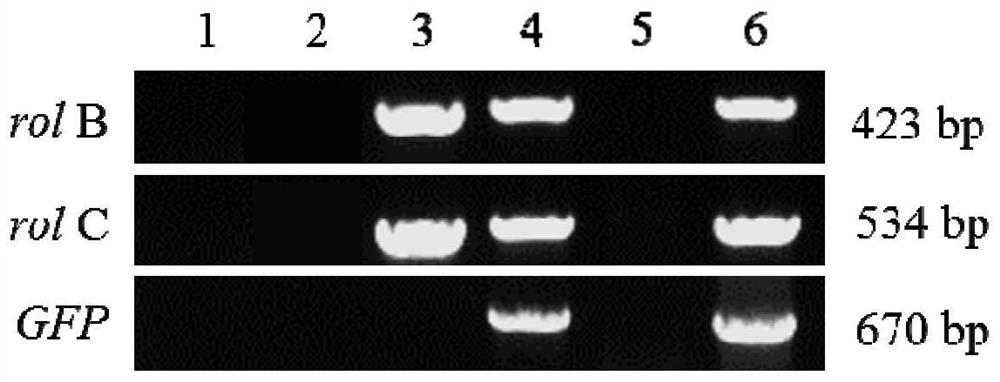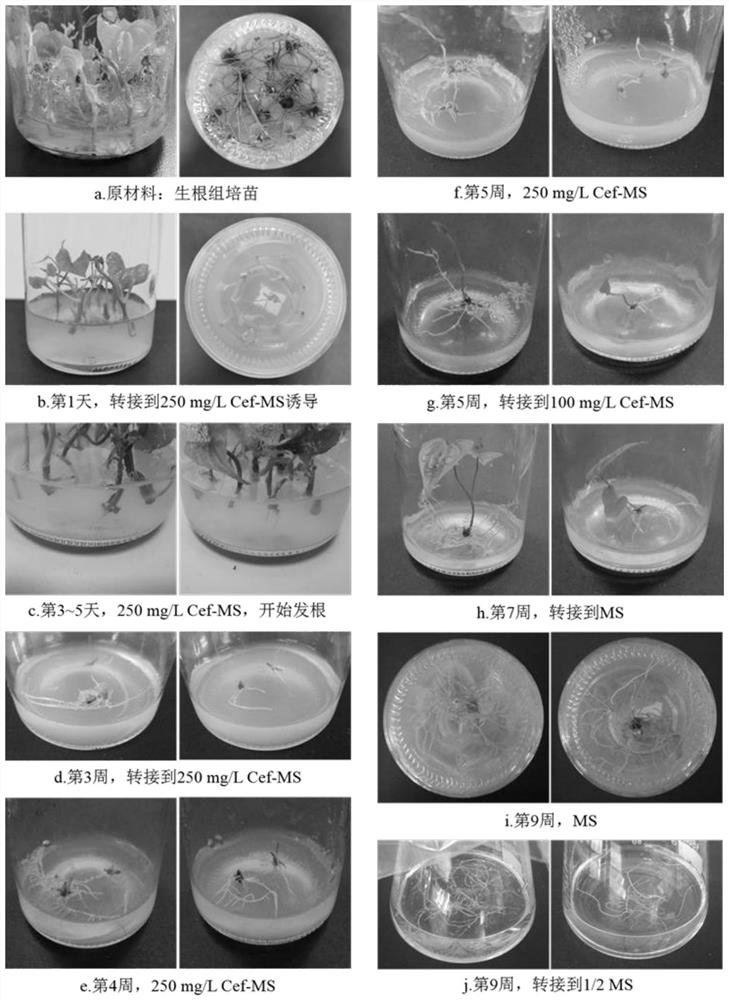Method for inducing transgenic hairy roots of dioscorea composita
A technology of diosminum chrysanthemum and hairy root, applied in the field of induction of transgenic hairy root of diosminum chrysanthemum, can solve the problem of low induction efficiency
- Summary
- Abstract
- Description
- Claims
- Application Information
AI Technical Summary
Problems solved by technology
Method used
Image
Examples
Embodiment 1
[0049] (1) Cultivation of tissue culture seedlings
[0050] Put the rooted tissue culture seedlings that have grown for about one month on the ultra-clean workbench, remove the roots with a scalpel, and transfer them to MS+0.1mg / L NAA+1.5mg / L 6-BA subculture medium after removing the roots Pre-cultivate for about 2 weeks in a tissue culture room at 25°C, with a light intensity of 2000 lx and a light time of 16 hours per day. Rooted tissue culture seedling materials see figure 1 -a.
[0051] (2) Preparation of genetically modified engineering bacteria
[0052] After two activations, Agrobacterium rhizogenes C58C1 was expanded and cultivated according to the inoculum size of 1%, and the bacterial liquid was cultivated to an absorbance of about 0.6, and then treated with 20mmol / L CaCl 2 Make competent cells, and then use the freeze-thaw method to transform the pCanG-GFP expression vector into the competent cells, culture at 28°C and 180r / min for 3 hours to recover the strains,...
Embodiment 2
[0073] (1) Cultivation of tissue culture seedlings
[0074] Put the rooted tissue culture seedlings that have grown for about one month on the ultra-clean workbench, remove the roots with a scalpel, and transfer them to MS+0.1mg / L NAA+1.5mg / L 6-BA subculture medium after removing the roots Pre-cultivate for about 2 weeks in a tissue culture room at 25°C, with a light intensity of 2000 lx and a light time of 16 hours per day.
[0075] (2) Preparation of transgenic infection bacterial liquid
[0076] Activate the genetically modified engineered bacteria C58C1+pCanG-GFP, and then expand the culture according to the inoculum size of 1%, and detect the absorbance OD of the bacterial solution with a UV spectrophotometer 600 About 0.6, centrifuge to collect the bacteria, then resuspend the bacteria with 1 / 2MS liquid medium containing 200 μmol / L acetosyringone (AS), and use an ultraviolet spectrophotometer to detect the absorbance OD of the resuspension 600 It is suitable to be 0.5-...
Embodiment 3
[0081] The AS concentration optimization of embodiment 3 hairy root induction
[0082]The concentration of AS used to induce hairy roots of Dioscorea chrysanthemum was optimized, and seven AS concentration gradients of 0 μM, 100 μM, 200 μM, 300 μM, 400 μM, 500 μM, and 600 μM were designed. Root induction. After infection and co-cultivation in the dark, the explants were transferred to 250 mg / L Cef-MS solid medium for culture. Within the first week of culture, the hairy roots of each experimental group were observed, except for the AS concentration of 0 μM In the experimental group, the remaining 6 experimental groups all began to grow roots. At the third week of cultivation, the number of hair roots and the number of pollution were counted for each experimental group, and the hair root rate and pollution rate of each experimental group were calculated. The results are shown in Table 1. Only the experimental group with an AS concentration of 0 had low pollution, and the rest ...
PUM
 Login to View More
Login to View More Abstract
Description
Claims
Application Information
 Login to View More
Login to View More - R&D
- Intellectual Property
- Life Sciences
- Materials
- Tech Scout
- Unparalleled Data Quality
- Higher Quality Content
- 60% Fewer Hallucinations
Browse by: Latest US Patents, China's latest patents, Technical Efficacy Thesaurus, Application Domain, Technology Topic, Popular Technical Reports.
© 2025 PatSnap. All rights reserved.Legal|Privacy policy|Modern Slavery Act Transparency Statement|Sitemap|About US| Contact US: help@patsnap.com



